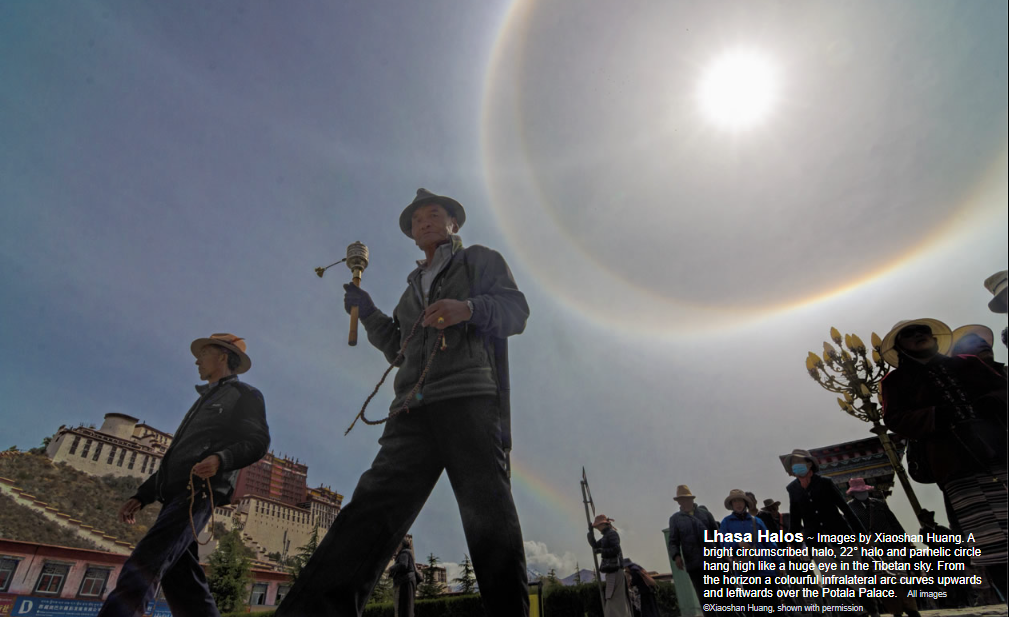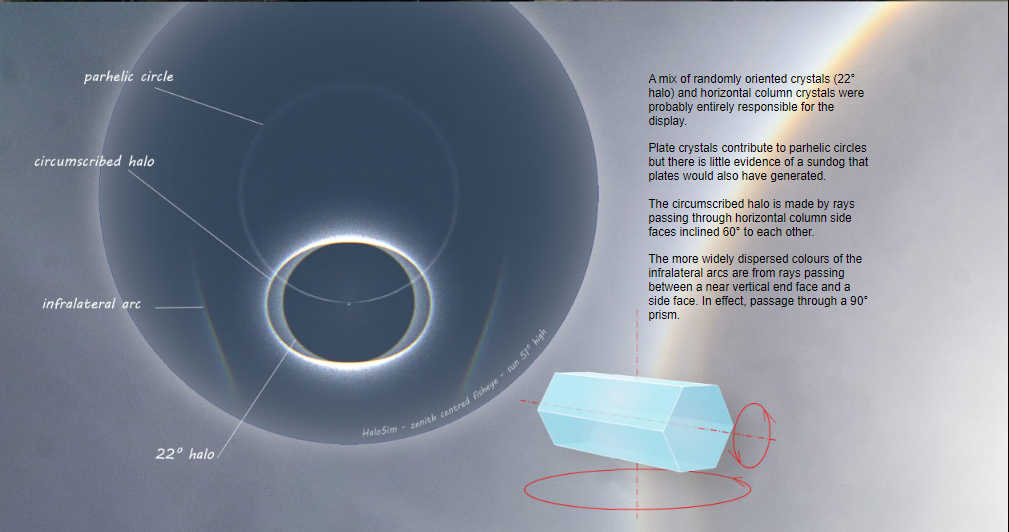Lhasa Halos - OPOD
Lhasa Halos: A Spectacular Atmospheric Optics Phenomenon
Have you ever gazed up at the sky and been captivated by the mesmerizing beauty of atmospheric optics? One such breathtaking spectacle is the display of Lhasa Halos in the Tibetan sky. These celestial wonders, photographed by Xiaoshan Huang, showcase a vibrant array of optical phenomena, including a circumscribed halo, a 22° halo, parhelic circles, and an enchanting infralateral arc. Let's dive deeper into the science behind these awe-inspiring phenomena and unravel their secrets.
Unveiling the Mystery: The Composition of Lhasa Halos
The Lhasa Halos are believed to be created by a combination of randomly oriented crystals, horizontal column crystals, and plate crystals. The presence of randomly oriented crystals contributes to the formation of the 22° halo, while horizontal column crystals are responsible for the distinct appearance of the circumscribed halo. The parhelic circles are predominantly influenced by plate crystals, which scatter light and create an ethereal circular pattern around the Sun. Interestingly, there is limited evidence of sundogs, which are typically associated with plate crystals.
The Enigmatic Circumscribed Halo
The circumscribed halo, a prominent feature of the Lhasa Halos, is formed by rays of light passing through horizontal column side faces that are inclined at an angle of 60° to each other. This unique arrangement creates a halo that encircles the Sun or Moon at a distance of approximately 22°. As the Sun's elevation changes throughout the day, the shape of the circumscribed halo undergoes dramatic transformations, adding an element of dynamism to this captivating phenomenon.
Exploring the Vibrant Infralateral Arc
One of the most striking aspects of the Lhasa Halos is the presence of a colorful infralateral arc that curves upwards and leftwards over the iconic Potala Palace. This arc exhibits a wider dispersion of colors compared to other optical phenomena observed in the sky. The vibrant hues are a result of light rays passing between a near-vertical end face and a side face, effectively creating the effect of passage through a 90° prism. This phenomenon adds an enchanting splash of color to the already mesmerizing display.
The Evolving Nature of Lhasa Halos
One fascinating characteristic of the Lhasa Halos is their ability to change shape with the elevation of the Sun. As the Sun moves across the sky, casting its rays at varying angles, the appearance of the halos undergoes significant transformations. These shape-shifting halos provide an ever-changing spectacle for observers, making each viewing experience a unique and awe-inspiring event.
Appreciating the Splendor of Lhasa Halos
The Lhasa Halos exemplify the captivating beauty and complexity of atmospheric optics. To fully appreciate this celestial phenomenon, it is best observed in clear skies with the Sun or Moon positioned at a particular elevation. Patience and a keen eye are key when attempting to witness these elusive halos. By immersing ourselves in the wonders of nature, we gain a deeper appreciation for the intricate interplay between light, atmospheric particles, and the boundless expanse of the sky.
Conclusion
The Lhasa Halos, with their circumscribed halo, 22° halo, parhelic circles, and vibrant infralateral arc, offer a captivating display of atmospheric optics in the Tibetan sky. The interplay between different types of crystals and their orientations gives rise to these mesmerizing phenomena. As the Sun's position changes, so does the shape and appearance of these halos, providing an ever-evolving spectacle that enchants all who witness it. By immersing ourselves in the beauty of atmospheric optics, we gain a deeper understanding of the intricate workings of our natural world. So, the next time you find yourself gazing at the sky, keep an eye out for the enchanting Lhasa Halos and let yourself be captivated by their awe-inspiring beauty.

Lhasa Halos ~ Images by Xiaoshan Huang. A bright circumscribed halo, 22° halo and parhelic circle hang high like a huge eye in the Tibetan sky. From the horizon a colourful infralateral arc curves upwards and leftwards over the Potala Palace. All images ©Xiaoshan Huang, shown with permission

A mix of randomly oriented crystals (22° halo) and horizontal column crystals were probably entirely responsible for the display.
Plate crystals contribute to parhelic circles but there is little evidence of a sundog that plates would also have generated.
The circumscribed halo is made by rays passing through horizontal column side faces inclined 60° to each other.
The more widely dispersed colours of the infralateral arcs are from rays passing between a near vertical end face and a side face. In effect, passage through a 90° prism.

The circumscribed halo/tangent arcs change shape dramatically with sun elevation.
Note: this article has been automatically converted from the old site and may not appear as intended. You can find the original article here.
Reference Atmospheric Optics
If you use any of the definitions, information, or data presented on Atmospheric Optics, please copy the link or reference below to properly credit us as the reference source. Thank you!
-
<a href="https://atoptics.co.uk/blog/lhasa-halos-opod/">Lhasa Halos - OPOD</a>
-
"Lhasa Halos - OPOD". Atmospheric Optics. Accessed on November 26, 2024. https://atoptics.co.uk/blog/lhasa-halos-opod/.
-
"Lhasa Halos - OPOD". Atmospheric Optics, https://atoptics.co.uk/blog/lhasa-halos-opod/. Accessed 26 November, 2024
-
Lhasa Halos - OPOD. Atmospheric Optics. Retrieved from https://atoptics.co.uk/blog/lhasa-halos-opod/.